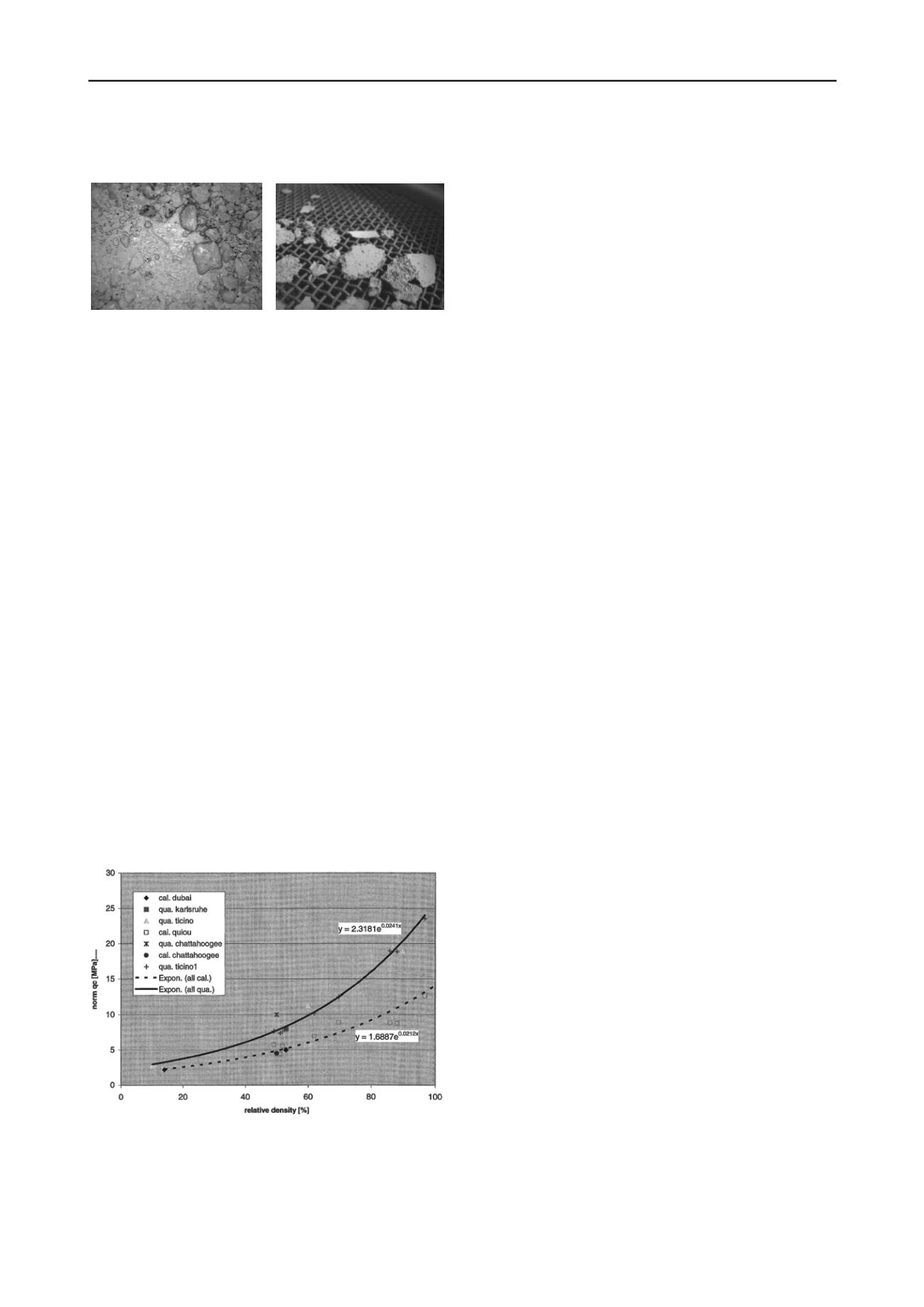
278
Proceedings of the 18
th
International Conference on Soil Mechanics and Geotechnical Engineering, Paris 2013
Proceedings of the 18
th
International Conference on Soil Mechanics and Geotechnical Engineering, Paris 2013
particles that are initially hidden in larger shells come loose
after manipulation.
Figure 6a and 6b. S2-sand after wetting and drying in the oven.
Even though crushing is most often evaluated through
granulometric distribution of equivalent grain diameters,
microscopic analysis of the sand grains is a useful addition to
fully quantify the effects of crushing as well as less invasive
abrasion and polishing. Microscopy allows for exact
measurement of grain dimensions, as opposed to a system of
sieves that is based on the assumption that particles are perfectly
spherical.
On a sample scale, Scanning Electron Microscopy might be a
useful tool for viewing the sand matrix and the intergranular
contacts, thus offering more insight in the effective stresses.
4 DEDUCTION OF SOIL MECHANICAL PROPERTIES
Findings from the laboratory tests must finally be translated to
geotechnical situations with crushable sand. On site conditions
are generally different from the laboratory: The very angular
shape of the grains causes an anisotropic behaviour; water and
temperature environment will be different; there is the scale
effect of the small-scale samples; ageing can cause cementation
that is hard to simulate in the lab. Crushing is a time effect and
therefore has more time to establish in the field than in the lab.
Corresponding to a continuous creep with time, the behaviour of
crushable sands also depends on the strain rate (Nutt and
Houlsby 1991), i.e. the possibility to form new structures
without crushing.
Correlations between geotechnical parameters that are based on
in situ experience with non-crushable sands, omit the specific
behaviour of crushable materials. As a solution, Wehr (2005)
links the differing best-fits between cone resistance and relative
density for silica and calcareous sand, through a “shell
correction factor” – without however revising the entire
correlation.
Figure 7. The correlations between relative density and cone resistance
for quartz and calcareous sands can be related through a “shell
correction factor” that depends on the relative density (Wehr 2005).
5 CONCLUSIONS
Just as research on sand differs from research on clay, crushable
sands also need a different approach from non-crushable,
cohesionless sands. Sample preparation, test procedure and
interpretation need revising to accommodate for the crushability
and the angularity of the grains. The phenomenon of crushing,
which causes the sand-grains and sand-structure to alter
significantly during a test, complicates testing and the used sand
should be closely monitored throughout.
Usage of a crushable sand causes grain degradation, which
manifests as erosion or breakage, anyhow altering the minimum
and maximum density of the sand. Consequently, unlike silica
sands, geotechnical parameters of crushable sands cannot be
derived through correlations with the calculated “relative
density”, which is sensitive to errors in the limit density
determinations and which has no real meaning for crushable
sand. By the same token, crushing cannot be evaluated through
sieving alone, a closer look at the grain morphology by means
of microscopy is required to fully understand the structure and
thus, the behaviour of crushable sands.
6 ACKNOWLEDGEMENTS
The authors acknowledge the Belgian Dredging company
DEME, for providing the sands used in this study.
7 REFERENCES
ASTM Standard D4254, 2000, “Standard Test Methods for Minimum
Index Density and Unit Weight of Soils and Calculation of Relative
Density,” ASTM International, West Conshohocken, PA, 2006,
DOI: 10.1520/D4254-00,
.
ASTM Standard D425, 2000 (2006), “Standard Test Methods for
Maximum Index Density and Unit Weight of Soils Using a
Vibratory Table,” ASTM International, West Conshohocken, PA,
2006, DOI: 10.1520/D4253-00R06,
.
ASTM Standard D2435, 1996, “Standard Test Methods for One-
Dimensional Consolidation Properties of Soils,” ASTM
International, West Conshohocken, PA, DOI: 10.1520/D2435-96,
.
ASTM Standard D422, 1963 (1998), “Standard Test Method for
Particle-Size Analysis of Soils,” ASTM International, West
Conshohocken, PA, DOI: 10.1520/D0422-63R98,
.
Hardin B.O. 1985, Crushing of Soil Particles,
Journal of Geotechical
Engineering
, ASCE, 111(10), 1177-1192.
JIS A 1224 Standard, 1992 (2009), Test Method for Minimum and
Maximum Densities of Sands, Japanese Geotechnical Society,
(in Japanese).
Ladd R.S. 1978. Preparing Test Specimens Using Undercompaction,
Geotechnical Testing Journal
, ASCE, 1(1), 16-23.
Nutt N.R.F. 1993, Development of the Cone Pressuremeter, DPhil,
University of Oxford.
Nutt N.R.F., Houlsby G.T. 1991, Calibration Tests on the Cone
Pressuremeter in Carbonate Sand,
Proceedings of the First
International Conference on Calibration Testing
, Potsdam, New
York, 265-276.
Semple R.M. 1988. The mechanical properties of carbonate soils
.
Proceedings of the International Conference on Calcareous
Sediments
, Perth, Australia, Vol. 2, 397-406.
Wehr J. 2005. Influence of the Carbonate Content of Sand on Vibro
Compaction,
Proceedings of the 6th International Conference on
Ground Improvement Techniques
, Coimbra, Portugal, 625-632.
Youd T.L. 1973. Factors Controlling Maximum and Minimum
Densities of Sands,
Evaluation of Relative Density and Its Role in
Geotechnical Projects Involving Cohesionless Soils
, ASTM STP
523, American Society for Testing and Materials, 98-112.


